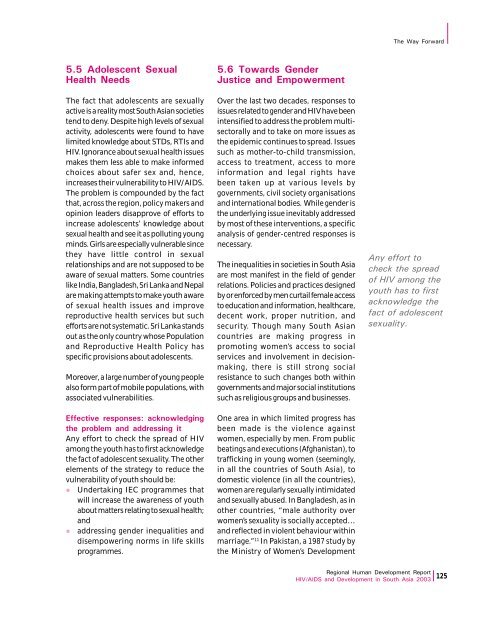Download Report - UNDP Asia-Pacific Regional Centre - United ...
Download Report - UNDP Asia-Pacific Regional Centre - United ...
Download Report - UNDP Asia-Pacific Regional Centre - United ...
You also want an ePaper? Increase the reach of your titles
YUMPU automatically turns print PDFs into web optimized ePapers that Google loves.
The Way orward5.5 Adolescent SexualHealth NeedsThe fact that adolescents are sexuallyactive is a reality most South <strong>Asia</strong>n societiestend to deny. Despite high levels of sexualactivity, adolescents were found to havelimited knowledge about STDs, RTIs andHIV. Ignorance about sexual health issuesmakes them less able to make informedchoices about safer sex and, hence,increases their vulnerability to HIV/AIDS.The problem is compounded by the factthat, across the region, policy makers andopinion leaders disapprove of efforts toincrease adolescents’ knowledge aboutsexual health and see it as polluting youngminds. Girls are especially vulnerable sincethey have little control in sexualrelationships and are not supposed to beaware of sexual matters. Some countrieslike India, Bangladesh, Sri Lanka and Nepalare making attempts to make youth awareof sexual health issues and improvereproductive health services but suchefforts are not systematic. Sri Lanka standsout as the only country whose Populationand Reproductive Health Policy hasspecific provisions about adolescents.Moreover, a large number of young peoplealso form part of mobile populations, withassociated vulnerabilities.Effective responses: acknowledgingthe problem and addressing itAny effort to check the spread of HIVamong the youth has to first acknowledgethe fact of adolescent sexuality. The otherelements of the strategy to reduce thevulnerability of youth should be:l Undertaking IEC programmes thatwill increase the awareness of youthabout matters relating to sexual health;andl addressing gender inequalities anddisempowering norms in life skillsprogrammes.5.6 Towards GenderJustice and EmpowermentOver the last two decades, responses toissues related to gender and HIV have beenintensified to address the problem multisectorallyand to take on more issues asthe epidemic continues to spread. Issuessuch as mother-to-child transmission,access to treatment, access to moreinformation and legal rights havebeen taken up at various levels bygovernments, civil society organisationsand international bodies. While gender isthe underlying issue inevitably addressedby most of these interventions, a specificanalysis of gender-centred responses isnecessary.The inequalities in societies in South <strong>Asia</strong>are most manifest in the field of genderrelations. Policies and practices designedby or enforced by men curtail female accessto education and information, healthcare,decent work, proper nutrition, andsecurity. Though many South <strong>Asia</strong>ncountries are making progress inpromoting women’s access to socialservices and involvement in decisionmaking,there is still strong socialresistance to such changes both withingovernments and major social institutionssuch as religious groups and businesses.One area in which limited progress hasbeen made is the violence againstwomen, especially by men. From publicbeatings and executions (Afghanistan), totrafficking in young women (seemingly,in all the countries of South <strong>Asia</strong>), todomestic violence (in all the countries),women are regularly sexually intimidatedand sexually abused. In Bangladesh, as inother countries, “male authority overwomen’s sexuality is socially accepted…and reflected in violent behaviour withinmarriage.” 11 In Pakistan, a 1987 study bythe Ministry of Women’s DevelopmentAny effort tocheck the spreadof HIV among theyouth has to firstacknowledge thefact of adolescentsexuality.<strong>Regional</strong> Human Development <strong>Report</strong>HIV/AIDS and Development in South <strong>Asia</strong> 2003 125
















